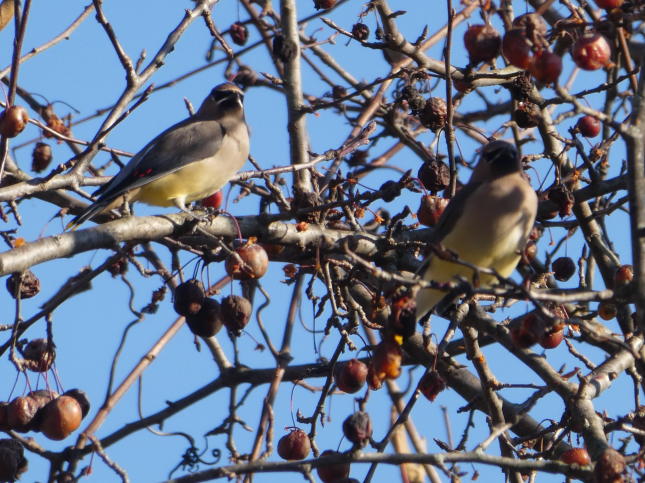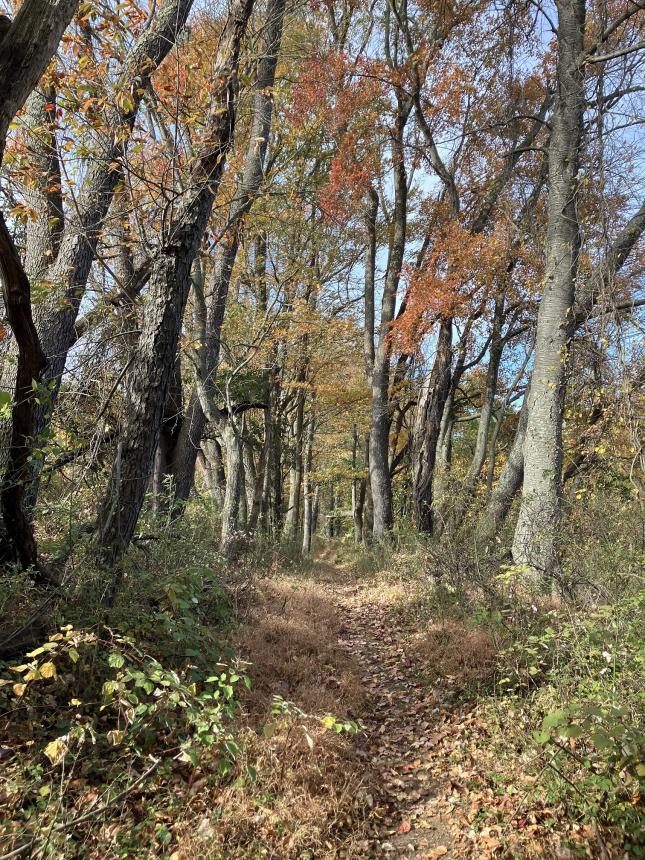
Cedar Waxwings on our Crabapple tree.
From Our Backyard
Sandy and I stepped out for our morning jaunt. Silent stars wink and shine in the face of a coming dawn. Deep in the wood, two Great-horned Owls softly converse in owl-speak. A hoo-hoo to you my feathered friends. Moonlight pools through the broken canopy. Lightly touching sections of the leaf strewn woodland for the first time since April. An unseen wind detaches leaves from up high. They whirl earthward like fallen embers. Each brittle leaf tells a tale of budding spring to basking in the summer sun to changing colors. Sandy meanders about sniffing out spoor of foraging nocturnal mammals like fox, raccoon, and deer. We do not travel any particular path, where her nose goes, I will follow.
The glowing light in the east illuminates the contrails of early departing airplanes. White straight-line puffy streaks of people going somewhere fast. No dark clouds or storm fronts on either horizon. The sere grass crackles underfoot. Rain has been lacking for some time and is not in any foreseeable forecast. Animals and birds seek out moisture in alternative places, like the sparkly frosty dew, bursting fruits, and insects. We have a squirrel that crawls along our deck rail each morning. He laps at the dewdrops to satisfy his thirst. Deer chew up the fallen crabapples. A Mockingbird plucks at the poke berries. Ruby-crowned Kinglets snatch insects from the air. Wildlife’s thirst for sources of water is of greater importance this fall than in the previous hotter season. At least during the summer rain fell weekly and at times in buckets. Our raccoons have taken to knocking over our birdbath at night but in good turn I fill it with fresh water each day for the birds. Most of us think these pleasant amber days gorgeous. I find the lack of lawn mowing to be soothing and the sound of leaf blowers to be ridiculous when the wind can do it effortlessly and economically. The lack of rainfall has affected the palette intensity of red, amber, and tawny in the scenery, but we need rain.
Lessening of daylight hours and the rare chilly night will cause your birds to eat more. Bird activity will depend on the quantity of natural foods in your habitat and what you provide at your feeders. I tend to see more birds at our feeders at first light or just before night falls. Peanuts are extremely popular in our feeders which is surprising given the vast amounts of acorns, walnuts, and hickory nuts dropped last month. The birds must have cached those nuts for later days. The Northern Flicker joined in with the other woodpeckers this morning to snatch peanut splits I set out in the tray feeder. The Flicker had to wait until the boisterous Blue Jays and raucous Crows plucked up the peanuts in the shell. Before I can turn my back, the Jays have landed. Once the nuts are depleted the noisy birds fly off and gentler birds like Titmouse and Chickadees can pick at the leavings. Cardinals are scarce in our yard. They are finding plenty of seed elsewhere.
The suet feeder and Bark Butter are starting to get more visitors too. The Red-bellied Woodpecker and the Carolina Wren love both products. Probably because they are high in fat and protein. A flock of eight to ten Bluebirds flit about the fields and occasionally visit the feeders for sunflower chips and dried mealworms. They are finding plenty of insects and bounties of berries everywhere, so they are satisfied. Goldfinch’s coats have faded like the leaves, they now appear drab compared to their summer frippery yellow. The natural world is transforming into the familiar brown of the Mourning Dove. If you are not seeing certain birds at your feeders do not fret. It is just that there is an abundance of natural foods in Mother Nature’s autumn larder.
Happy Birding, Charles

There are paths we travel on that are old or are foggy recollections of the mind. I find it pleasing to walk down a forgotten road or thoughtfully trip through childhood memories on a fall afternoon. You can imagine the horses, wagons, and feet that trod the path long ago. Or romanticize that people were nice and kind to each other back then. The reality is that life was trying and filled with hardship, and some people were filled with animosity towards their neighbor. Roads have been improved for automobiles or foot trails but people do not seem to change.



